Dutch Oven vs Braiser: Which Is One Should You Buy?
If you are new in the kitchen, you would probably confuse a Dutch oven with a Braiser – do not feel bad – until I started researching and looking into the difference between them I was a bit unsure also.
Making a purchasing decision means you do need to understand the Dutch oven vs Braiser key features so you get the right one.
In a world of enamel cast iron cooking, almost every pot looks the same but they actually do vary in function.
There is so much choice today it is easy to get overwhelmed. There are cast iron pots, cast iron skillets, griddles, woks, and more. However, a good enameled cast iron cookware like a tramontina or le creuset signature range braiser pan is a fantastic addition to your kitchen equipment. They are definitely durable, functional, and produce some amazing results.
If you are cooking for a big group you can get extra-large Dutch ovens, also see our review of the best large pots when cooking for a group.
All Clad cookware is also a famous brand worth looking at.
In this article, we will explain the exact differences between a Dutch oven versus a Braiser. Plus we will cover what exactly they are good at cooking and why. We will also give you the best options for various cooking methods with each type.
We also compare a Dutch Oven vs Crock Pot or Slow cooker
What is a Dutch Oven?
Cast iron Dutch ovens are available in several sizes, forms, shapes, and uses. This is the type of equipment that excels in cooking food gently over a long time or what they professionally call “slow cooking”.
The cooking method makes use of the thick cast iron with higher sides and a thicker base, much more than other cookware. These are the ovens that are used for deeper cooking to keep the moisture in often with special lids like a domed lid. They are great for simmering, and for slow cooking whole pieces of meat at moderate temperature, brisket is a good example.
You need a heat source that you can control with precision (eg gas or induction) this will give a good heat distribution which results in consistent heat for your pot roast or cast iron pan chicken thighs.
A Staub dutch oven or le Creuset are good conductors of heat with excellent heat retention giving a great cooking surface inside. A good quality one like a le Creuset dutch oven can also be used for shallow frying. For example- frying pork chops perfectly.
Because of the heat retention, they can be used as an everyday pan or even as a replacement for a saute pan.
While some seasoned cast iron Dutch ovens will not stay being nonstick for too long, especially if they are made with low-quality materials. These kinds of Dutch ovens should not be placed in the dishwasher or cleaned with aggressive cleaners. (see our notes below on this)
TLDR
A Dutch oven can kind of be a substitute for a braiser, but a braiser is unable to be a Dutch oven. The reason being The main difference is in the height of the walls on the pan.
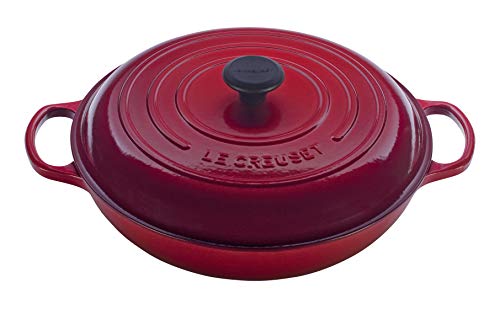
le Creuset braiser 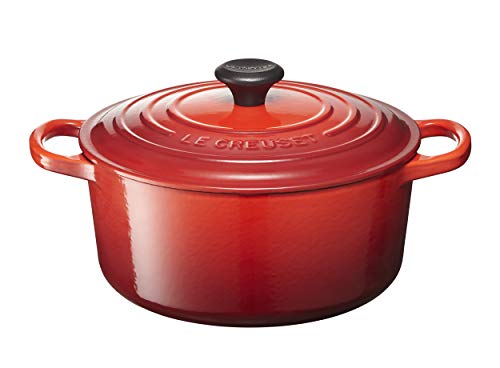
le Creuset Dutch Oven
What is a Braiser?
Braisière saucepans are also known as everyday pots in many European cooking countries such as France, Spain, and Holland.
They are made of the same material used with Dutch ovens, which is enamel cast iron. Unlike the previous cookware, it can be bought in different shapes and designs. It looks more shallow and is often bigger in footprint or with longer sides to make space for whole cuts of meat.
Braisers are mostly made of cast iron which causes the braiser to get good and hot in order for it to sear the food. The temperature will then remain high after adding liquid increasing the cooking temperature.
I would only buy enameled cast iron cookware because it just makes them more versatile. They can be used to cook pasta with a tomato sauce, or as a slow cooker. When you have experience setting the temperature just right you can get some amazing results – just like an instant pot – which we have a lot of recipes for. Of course used as a braising pan (see le creuset braiser) is a key cooking method for these.
Instead of using it for simmering, it is used for braising, searing, and producing brown meat since it holds a steady temp easily. A braiser produces a tender cut of meat with no uneven portions. And since it comes more shallow than a Dutch oven, but has a larger footprint it gives a generous amount of space or room to sear a prime rib or brisket.
And like a Dutch oven, it has a tight-fitting lid.
So an enameled cast iron braiser from the le Creuset cookware range is a welcome addition to any kitchen. These can actually replace an old cast-iron skillet.
Another thing you need to know about a braiser is that it’s not high-sided, so it can not handle a whole chicken or a pork butt for example.
What is a Dutch Oven Good For?
When you use a cast-iron Dutch oven in cooking your dish, it will submerge all the tough cuts of meat into the liquid because of its depth. It is famous for its high level of condensation during the process of cooking and maintaining the heat, making it a great option for a consistent heat source. While using this cookware, it will allow you to pour more liquids and stir as much as you want since it has a wider and taller build.
Cooking soups, stews, roasts, beans, chili, vegetables, and large meats are certainly fine with Dutch ovens. Having a better grip is also made possible through its tight-fitting lid, as well as cooking for a longer period of time to create tender meats.
In order to contain the consistent heat and for the steam not to escape from the Dutch oven, you need to choose one with a heavy self-sealing lid.
Moreover, if you plan to start to use one, set your stove to low heat and let the cast iron oven heat for eight to ten minutes for even heating without any cold spots. If you want it to last for several years, do not use it in extreme heat.
How Does a Dutch Oven Work?
Cuts of meat come into play for cooking with these pots – because you can cover all the meat with the liquid you get pull-apart tender dishes. In these types of dishes, the notion is to have the food submerged and fully surrounded by liquids.
The meat is then slowly cooked with extremely low heat over a long period of time. This allows the meat to tenderize with little effort to the cook preparing the dish. A lid is positioned firmly on the top, which keeps all steam inside and drips into the bottom of the bowl preventing it from escaping while cooking.
The result is a really tender and nourishing main or entree.
This combination of all the mentioned properties which are inherent in a Dutch oven can lead you to come up with this very handy method for achieving high-quality results while using it on any controlled heat source.
What is a Dutch Oven good For
- stews
- casseroles
- pot roasts
- baking
- soups
- chili
- beans
- frying
- sauteing
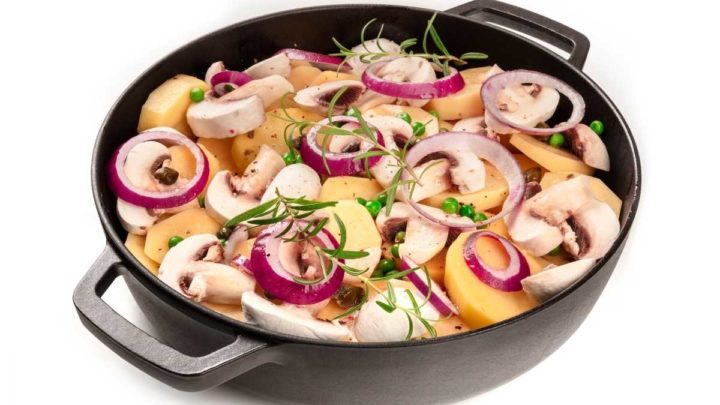
What is a Braiser Good For?
An enamel cast iron braiser is best in retaining the juices from any kind of meat during the cooking process even at low temperatures. Its wide opening is great for sautéing and searing the food as part of the cooking method. Braising the dish means it is a little like slow cooking except that it does not need to be covered all throughout to completely retain the liquid and soften the meat.
Using a braiser will need you to preheat it for 5 to 8 minutes at a low temperature to get an even temperature before cooking. Whether you use a stovetop or oven, a braiser works in both ways for cooking.
As mentioned, it will not need high heat when browning the meat since it typically has a thinner base compared to a Dutch oven. Also, the liquid produced from a braiser will help break down the food, hence making the meat more tender without uneven spots.
Braisers are often used in lamb shanks, chicken cacciatore, and pork chops both in red and white wine as well as other braising liquids. The food is made to simmer on the stove. While many love braising recipes of meals such as one-pot-pasta recipes.
In other words, use a braiser if you want to do these:
- browning of meats
- steaming and simmering
- preparing paella, beans, risotto, and more
- stir-frying
A Handy Table Showing The Difference Between a Dutch Oven and a Braiser
You will have noted the similarities between these two different pots and in this little handy table we give you a side-by-side comparison so you can see the differences.
Dutch Ovens
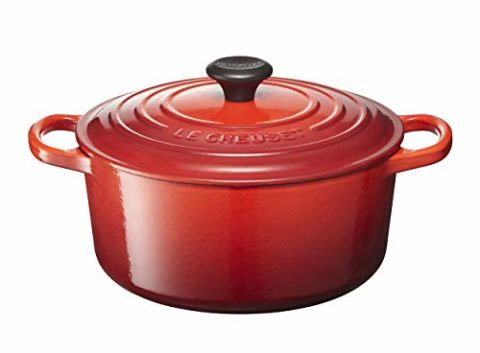
Dutch Ovens is a great cookware that can do a variety of ways to cook including cooking shallow and deep fry, stewing, roasting, steaming, baking and more.
Dutch oven stewing allows the tough pieces of meat cooked fully in liquid. This results in a fall of the bone, pull-apart tender meat.
Dutch oven sizes 1-qt up to 18-qt
Dutch ovens are manufactured from seasoned cast iron or enamel-coated cast iron.
The Shape of a Dutch oven can be round or oval.
Dutch oven bases are flat which makes even heating, plus they can have legs for campfire use.
Dutch ovens will have a handle on the side of the oven. Some will also have a wire bail handle for use on a campfire.
The lids on a Dutch oven are heavy and seal well on the top so that the heat and steam are retained inside. To enable self-basting some lids have nodules or spikes.
Braising Pots
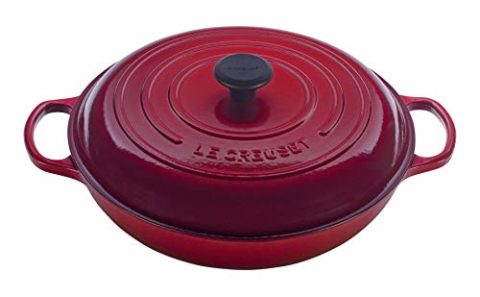
A braiser will let you carry out almost all the cooking methods of a Dutch oven apart from stewing and deep-frying. Because it has only shallow sides this limits the amount of liquid or broth you can use in you cooking. So these are not quite as versatile.
The braiser’s wide design allows for limited liquid in the pan. The braisers have a flat bottom and a slightly concave shape on the bottom.
Dutch oven sizes 1-qt up to 8-qt
Braisers ovens are manufactured from enamel-coated cast iron. So care needs to be taken in cleaning
The Shape of Braiser can be round or oval or oblong.
Braiser bases are flat which makes even heating. They also can have a plate insert for extra heat retention.
Braiers will also have a handle on the sides. But they do not have a wire bail handle.
The lids on a Braiser are heavy and seal well on the top so that the heat and steam are retained inside. To enable self-basting some lids have nodules or spikes.
Should You Get A Braiser or Dutch Oven?
Getting either one of these pieces of cookware will depend on your usual routine in the kitchen. Though both can allow a wide range of dishes, they are best used for a specific type of cooking. However, if you have a limited budget, we suggest you go for the Dutch oven since it can adapt to recipes that require the use of braiser. But unless your usual recipes need a braiser, then go for one.
But if you have a bigger budget for purchasing, then go for a high-quality, expensive braiser.
But if you want to have both, then it would be better, especially if you regularly cook different types of dishes that need to use both of the cookware pots. Again, both cookware is very similar in materials and designs.
Can I use a Dutch oven for braising?
A Dutch oven can be used as a braiser but a braiser cannot be used as a substitute for a Dutch oven. For an instance, a braiser is best for simmering food in a small amount and for shallow frying. And both of these methods can be done in a Dutch oven. While a Dutch oven is best for soups and stews, but these methods cannot be done in a braiser.
What size of Braiser should I buy?
An essential braiser for all types of cooking should have a measurement of at least 3 3/4- to 4-quart if you will be cooking for a medium-sized crowd. While a 5-quart braiser or larger is needed if you will be cooking for a large group or crowd.
What shape of Dutch oven should I buy?
A round Dutch oven is what everyone uses for even and consistent heat distribution in cooking. While professionals suggest that an oval-shaped Dutch oven is good for longer cuts of meat, like a leg of lamb. It is also best for roasting meats in large cuts without constraints set by a round oven.
What is Enamel Cast-iron?
An enameled cast-iron is mostly used in high-quality pots since it provides a natural non-stick coating on the surface. This material is also considered safe as regulated by FDA’s Center for Food Safety and Applied Nutrition. It is best if you want to cook with a lot of oil, liquid, or low cooking temperatures in a shallow pot.
How To Clean Enamel Cast Iron
On the whole Enamel cast iron is non-stick and pretty easy to clean. The quality of the enamel does matter and that is why I would recommend getting a better quality like a le Creuset braiser or Dutch oven.
Always use softer clothes or wooden utensils to clean an enameled Briaser or Dutch Oven Plastic and metal can scratch the surface over time if too much pressure is applied and reduce the lifespan of the material.
Let them soak overnight in water if you have very dirty dutch once or your braiser has got too hot and is covered in hard-to-remove food.
Most cast iron cookware manufacturers insist that enamel-coated products can go in the dishwasher – however don’t follow this assumption! Purists like myself favor handwashing, stirring a drop or two of dish soap into tepid water, and cleaned carefully using a soft pad.
Should I buy a Braiser or a Dutch oven?
We hope we have clearly differentiated to you the difference between the two famous pots. If you plan to purchase, make sure that you have understood your needs and check what will perfectly match them.
If you regularly cook in small portions, choose a braiser that you can use for either braising or as a skillet. If you are looking for an all-around pot, get an enameled dutch oven or a double dutch oven. We would not recommend substituting either of them since braisers do their job better than Dutch ovens and the other way around.